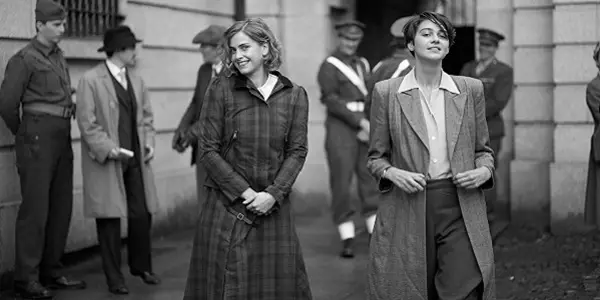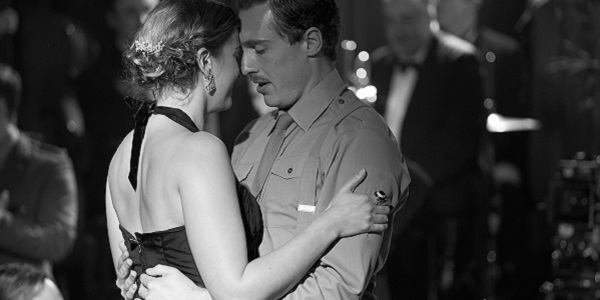LOLA - Turn And Face The Strange
Published by Reblogs - Credits in Posts,
The feature debut of director Andrew Legge, LOLA is a high-concept, low-budget time travel film that chronicles what happens when two sisters in 1940 invent a machine that can intercept radio and television broadcasts from the future.

Co-written by Legge with Angeli Macfarlane, LOLA is presented to the audience as though it were a collection of old movie reels recently discovered in an abandoned house, purportedly left behind by one sister for another. Yet while the film’s fascinating premise captures the imagination instantly, the execution doesn’t quite measure up to that initial promise.
We Could Be Heroes
When orphaned sisters Thomasina (Emma Appleton) and Martha (Stefanie Martini) decide to test out their newly invented contraption (called LOLA, after their mother), the first broadcast they manage to intercept is a video of an unusual, androgynous man performing a song about an astronaut named Major Tom. The artist who became the icon known as David Bowie has not even been born yet, but his presence in their home electrifies the sisters, giving them a glimpse of a future that is full of excitement and promise. But as the Blitz engulfs their homeland of England in fiery explosions, Thomasina and Martha (who also go by the annoyingly edgy nicknames Thom and Mars) realize their invention can be used for so much more than listening to the music of Bob Dylan and watching the movies of Stanley Kubrick.

source: Dark Sky Films
By intercepting reports of bombing attacks from the future, then issuing warnings to the surrounding areas beforehand, Thom and Mars can save thousands of lives. Naturally, their alarmingly prescient broadcasts attract the attention of British intelligence, in particular Lieutenant Sebastien Holloway (Rory Fleck-Byrne). As Mars starts to fall in love with the young officer, Thom grows more and more infatuated with the power of LOLA. Yet as anyone who has ever enjoyed a time travel story must know, changing the present can have unforeseen effects on the future, and Thom’s obsession with using her power to destroy the Nazis ends up paving the way for them to rise to power in new and unexpected ways. Their first sign something has gone wrong? When David Bowie’s broadcasts from the future are suddenly replaced by performances of neo-fascist pop.
The Freakiest Show
To give the audience the feeling that we’re watching reels of found footage, cinematographer Oona Menges shot LOLA on black and white film with vintage cameras equipped with period-appropriate lenses; the footage was then processed in an old-fashioned 16mm developing tank to give it that extra retro feel. All of this extraordinary effort is impressive for a low-budget feature, and it certainly gives LOLA a unique aesthetic compared to many other contemporary science-fiction films. Yet somehow it still all looks alarmingly modern; the film looks like a modern movie masquerading as an old one, not an authentic piece of 1940s moviemaking. If the main characters are the ones who shot most of the footage, wouldn’t it bear more of a resemblance to the kinds of films they go to the theaters to see? (Yes, they’ve been exposed to 1960s cinema, but LOLA doesn’t look like Kubrick either.) I’ve seen enough movies from the classic era to have a proper sense of their look and feel, and LOLA—as compelling as many of its visuals might be—just doesn’t have it.
Unfortunately, I think a large part of that is due to the cast, who not only look strangely modern for a film set in 1940 but also aren’t terribly convincing actors. Many scenes in LOLA feel excessively histrionic due to the intense way the trio of leads delivers most of their dialogue; they sound as though they are performing on a stage and projecting to the back row, not having discussions at home that are being recorded by themselves for posterity. And yes, Thom and Mars are supposed to be strong, forward-thinking young women, raised by intellectual parents who apparently taught them that gender was a construct (did that phrase even exist in 1940?), and yes, they have invented a machine that exposes them to culture far more modern than their own…but even keeping all of that in mind, I was not able to suspend my disbelief enough to believe that these two were from the year 1940. I admired their characters, I even liked them, but I did not believe in them. (At least they were interesting, which is more than can be said for the poor lieutenant.)

source: Dark Sky Films
What I did believe, and thoroughly enjoy, was LOLA’s depiction of the evolution of pop culture, and the way changing the past is guaranteed to change the art of the future. When Thom’s excessive meddling ends up altering the outcome of the war for the worse in a way she never expected, and the British fall prey to fascism, of course, David Bowie immediately disappears. After all, how could such an eccentric symbol of freedom and individuality ever exist in a world controlled by Nazis? Instead, he’s replaced by some disturbing yet hilarious new artists who sing songs with lyrics like "Don’t fraternize with radicals and perverts/learn to march in time and fall in line."
The scariest part of LOLA is how catchy these songs are—they’re still bops, just frightening, fascist ones—and how easily one can imagine music like this becoming popular among certain people today if our world keeps turning in the same direction. The film’s songs are provided by Neil Hannon of The Divine Comedy, who has coincidentally also contributed songs to an iconic piece of time travel-oriented entertainment (Doctor Who) as well as the theme music for some beloved British sitcoms (Father Ted, The IT Crowd). His incredible music does more to make the weird world of LOLA feel real than all of the pseudo-retro visual trappings ever could.
The film is also extraordinarily well edited by Colin Campbell, who cuts between the sisters’ home video footage, actual documentary footage of 1940s England, and fake newsreel footage created for the film that illustrates the alternate future that Thom inadvertently helps to create. Yet all of this exceptional editing almost makes the central conceit of LOLA—that we’re watching reels edited together by Mars to show Thom the consequences of her actions—even more outrageous; after all, it’s hard to imagine Mars, as talented of a filmmaker as she may be, sitting down at a Steenbeck to create this crazy collage of footage when a fascist regime is dogging her every move. Still, one cannot deny how fascinating it is to get a glimpse of a world that came so dangerously close to being—and could still come to fruition if we’re not careful.
Conclusion
Lofty in ambition yet flawed in realization, LOLA is nonetheless an intriguing experiment in lo-fi science-fiction—not to mention, a cautionary tale of the kind of artistic expression we can expect under fascism.
LOLA is available in select theaters and VOD on August 4, 2023.
Watch Lola
Does content like this matter to you?
Become a Member and support film journalism. Unlock access to all of Film Inquiry`s great articles. Join a community of like-minded readers who are passionate about cinema - get access to our private members Network, give back to independent filmmakers, and more.
